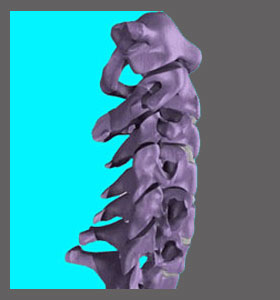
Cervical foraminal stenosis is a very common potential source of neck pain due to nerve compression within the neuroforamen. While there are many possible causes for foraminal narrowing to occur, a few are virtually universal within the neck anatomy. Osteoarthritis in the neck will create bone spurs and arthritic debris which can certainly decrease the overall size and viability of the foraminal openings. Degenerative disc disease can bring the vertebral bones closer to one another, naturally limiting the size of the spaces through which the nerve roots exit. Both of these conditions are virtually universal in the cervical spine. Furthermore, the incidence of herniated discs in the neck is also incredibly commonplace, adding yet another contributor to narrowing of the nerve foramen.
This focused dialog explores stenosis of the neural foramen in the cervical spinal region.
What is Cervical Foraminal Stenosis?
Foraminal stenosis is a condition where the openings through which spinal nerves exit the canal becomes decrease in size. A fully open neural foramen is rare in adults, since arthritic and disc-related changes will narrow many of these unilaterally or bilaterally, particularly in the middle to lower cervical levels and in the lower lumbar regions.
Stenosis is a term which means a narrowing, like when pinching a straw. Therefore, stenosis of the neuroforamen in the cervical spine is a condition where the normally patent nature of the space is compromised by one or more structural issues. In many scenarios, it is actually a variety of causes and contributors which decrease the size of particular foramen.
Cervical Foraminal Stenosis Symptoms
Foraminal narrowing by itself is harmless. To clarify, this means that the foramen does not feel any pain from being reduced in space. However, there is a nerve running through this hole and when the size of the opening is limited, the nerve may be compromised by the tight fit through the normally patent space. This is called a compressive neuropathy, or in common terms, a pinched nerve.
In the neck, the possibility for pinched nerves to occur is quite good, since the foraminal spaces are small to begin with and the osteoarthritic and disc desiccation process are almost always present.
When a nerve is pinched slightly, it may be painful and create some tingling feelings in the area served. These symptoms are no likely to endure for long. However, if the foraminal space is closed off significantly and the nerve suffers ongoing true compression, then a completely different picture emerges.
True nerve compression causes pain at first, followed by progressive tingling, then true objective weakness and numbness in the area of the body innervated by the affected nerve structure. True pinched nerves should not create chronic pain, nor should they present lasting pins and needles, subjective weakness or subjective numb sensations permanently. In these cases, the diagnosis of a pinched nerve may be incorrect, despite some degree of foraminal narrowing.
Presentation of Cervical Foraminal Stenosis
So, to wrap it all up, picture the poor nerve trying to go about its merry way through the foraminal space when the proverbial door closes tightly. This is a pinched nerve. The facts show that many cases of suspected neuropathy are incorrectly identified, usually through one of the following pieces of supportive evidence:
Symptoms exist, but diagnostic imaging shows patent foramen.
Symptoms do not correlate by location to affected nerve.
Symptoms are too diverse to come from single level compression.
Compression seems to occur unilaterally, but symptoms are bilateral or on the opposite side as the theorized compression.
If any of these situations applies to you, but you have still been diagnosed with a pinched nerve stemming from foraminal narrowing, be sure to talk to your doctor about the possibility for other structural or nonstructural causes.
Many pinched nerves are diagnosed without evidence and treatment begins based on assumption. Unfortunately, since the diagnosis may not be correct, the therapies used are likely to fail from the get-go. Poor treatment statistics for compressive neuropathies which do not present the typical symptomatic profile support this statement 100%.
Spinal Stenosis > Neuroforaminal Stenosis > Cervical Foraminal Stenosis





